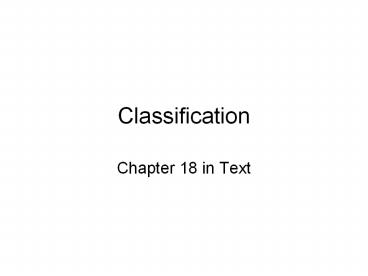Classification - PowerPoint PPT Presentation
Title:
Classification
Description:
Classification Chapter 18 in Text Ernest Rutherford (1871-1937) Scientist father of nuclear physics , radioactivity All science is either physics or stamp ... – PowerPoint PPT presentation
Number of Views:85
Avg rating:3.0/5.0
Title: Classification
1
Classification
- Chapter 18 in Text
2
Ernest Rutherford (1871-1937)
- Scientist father of nuclear physics,
radioactivity - All science is either physics or stamp
collecting
3
Why Classify?
- The biosphere consists of more than 1.5 million
animal species, and as many plant species. - The species alive today are only a very small
percentage of the perhaps billions of species
which have lived on Earth since life first
evolved over 3.5 billion years ago. - Over 75 of the described extant species belong
to the Phylum Arthropoda, which includes such
diverse organisms as lobsters, barnacles, crabs,
scorpions, shrimp, spiders, mites, millipedes,
and insects. The insects are by far the most
abundant arthropods. - To study this many organisms, biologists need to
have a standard, logical method of naming and
grouping organisms.
4
Taxonomy
- Taxonomy (Gr. taxis, "arrangement, order", nomos,
"law") is the science, laws, or principles of
classification (Latin, classis, "a class",
facere, "to make").NOT - Taxidermy - the art of preparing and preserving
the skins of animals and of stuffing and mounting
them in lifelike form (taxis, (see above),
dermis, skin).
5
- Rainbow Trout
- Oncorhynchus mykiss
6
- Oryx (Gemsbok)
- Oryx gazella
7
How to Sort
- Group by similarities and differences in physical
characteristics - Group by lines of evolutionary descent,
similarities in fossil record. - Group by similarities in embryological
development - Group by genetic similarities and differences
8
Carl Linnaeus
- Swedish 1707-1778
- Father of modern taxonomy
- Naming system binomial nomenclature
9
Linnaeuss System
- Kingdom
- Phylum
- Class
- Order
- Family
- Genus
- Species
10
(No Transcript)
11
Binomial Nomenclature
- Linnaeus, 1700s
- 2 part scientific name
- Genus and species
- Homo sapiens Panthera leo
- Oryx gazella
12
Dichotomous Key
- Method of classification by differences in
physical characteristics - Look at pages 462-463 in text
13
How to Sort Again!
- Group by similarities and differences in physical
characteristics. (Shark)
14
Which name followed the instructions?
- Teddy
- Jmizzle
- Octocorn
15
How to Sort Again!
- Group by similarities in embryological
development
16
How to Sort Again!
- Group by lines of evolutionary descent,
similarities in fossil record.
17
How to Sort Again!
- Group by genetic similarities and differences































